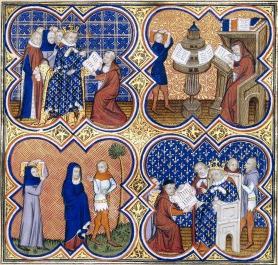|
P. C. Kokila
P. C. Kokila is an Indian professor of Hindi, who is best known for translating the Tirukkural into Gujarati. Biography P. C. Kokila was born in Bhavnagar in Gujarat. In 1981, she completed her bachelor's degree in mathematics from the University of Madras. She completed her MA in Hindi from the Dakshin Bharat Hindi Prachar Sabha in 1984 and went on to obtain an MPhil in 1986 and a doctorate in 1994. In 1998, she completed her MA in philosophy and religion from the Madurai Kamaraj University. She began her career in 1986 as a Hindi pradhyapika (pundit) in Hindi Teaching Scheme of the Indian government's Ministry of Home Affairs. From 1988, she has been working in the Hindi department at the Presidency College in Chennai and became the associate professor and head of the department. She has presented 24 research papers, of which 16 have been published. Kokila translated the ancient Tamil moral work of the ''Tirukkural'', which was published in 2015 by the Central Institute ... [...More Info...] [...Related Items...] OR: [Wikipedia] [Google] [Baidu] |
Bhavnagar
Bhavnagar is a city in the Bhavnagar district of the Saurashtra region of Gujarat, a state of India. It was founded in 1723 by Bhavsinhji Takhtasinhji Gohil (1703–1764). It was the capital of Bhavnagar State, which was a princely state before it was merged into the Indian Union in 1948. It is now the administrative headquarters of the Bhavnagar district. Bhavnagar is situated 190 kilometres away from the state capital Gandhinagar and to the west of the Gulf of Khambhat. It has always been an important city for trade with many large and small scale industries along with the world's largest ship breaking yard, Alang which is located 50 kilometres away. Bhavnagar is also famous for its version of the popular Gujarati snack 'Ganthiya' and 'Jalebi'. History The Gohil Rajput of the Suryavanshi clan faced severe competition in Marwar. Around 1260 AD, they moved down to the Gujarat's coastal area and established three capitals: Sejakpur (now Ranpur), Umrala, and Sihor. Sejak ... [...More Info...] [...Related Items...] OR: [Wikipedia] [Google] [Baidu] |
Chennai
Chennai (, ), formerly known as Madras ( the official name until 1996), is the capital city of Tamil Nadu, the southernmost Indian state. The largest city of the state in area and population, Chennai is located on the Coromandel Coast of the Bay of Bengal. According to the 2011 Indian census, Chennai is the sixth-most populous city in the country and forms the fourth-most populous urban agglomeration. The Greater Chennai Corporation is the civic body responsible for the city; it is the oldest city corporation of India, established in 1688—the second oldest in the world after London. The city of Chennai is coterminous with Chennai district, which together with the adjoining suburbs constitutes the Chennai Metropolitan Area, the 36th-largest urban area in the world by population and one of the largest metropolitan economies of India. The traditional and de facto gateway of South India, Chennai is among the most-visited Indian cities by foreign tourists. It was rank ... [...More Info...] [...Related Items...] OR: [Wikipedia] [Google] [Baidu] |
Translators Of The Tirukkural Into Gujarati
Translation is the communication of the Meaning (linguistic), meaning of a #Source and target languages, source-language text by means of an Dynamic and formal equivalence, equivalent #Source and target languages, target-language text. The English language draws a terminology, terminological distinction (which does not exist in every language) between ''translating'' (a written text) and ''Language interpretation, interpreting'' (oral or Sign language, signed communication between users of different languages); under this distinction, translation can begin only after the appearance of writing within a language community. A translator always risks inadvertently introducing source-language words, grammar, or syntax into the target-language rendering. On the other hand, such "spill-overs" have sometimes imported useful source-language calques and loanwords that have enriched target languages. Translators, including early translators of sacred texts, have helped shape the very l ... [...More Info...] [...Related Items...] OR: [Wikipedia] [Google] [Baidu] |
List Of Translators
This is primarily a list of notable translators. Large sublists have been split off to separate articles. By text * List of Bible translators * List of Qur'an translators * List of Kural translators * Harry Potter in translation By target language Into Arabic * Ahmed Shawqi * Hafez Ibrahim * Ibn al-Muqaffa' * Rifa'a el-Tahtawi * Taha Hussein – translator of Sophocles, Racine, and others *Hafs ibn Albar Into Albanian *Faik Konitza * Fan Noli * Luan Rama *Petro Zheji *Robert Shvarc *Mirela Kumbaro Into Armenian * Levon Ananyan * Vahagn Davtyan * Hovhannes Masehian * Vahan Malezian *Yervant Odian * Nahapet Rusinian * Hamo Sahyan * Vardges Sureniants * Leon Surmelian * Alexander Tsaturian * Rita Vorperian Into Azerbaijani (Azeri) *Hamlet Isaxanli (Isayev) – translator of poems from Russian, English and French Into Bulgarian * Albena Bakratcheva * Valeri Petrov *Nikolai B. Popov Into Chinese *Chen Liangting * Huang Ai – translator of '' Oliver Twist'' by Charles Dickens ... [...More Info...] [...Related Items...] OR: [Wikipedia] [Google] [Baidu] |
Tirukkural Translations Into Gujarati
As of 2015, there were at least three Gujarati translations available of the Tirukkural. Background The Kural remained unknown to the people of Gujarat during the medieval period as none has made any reference to the work in their writings. The Kural became more known to Gujarati people during the period of the Indian Independence movement after Mahatma Gandhi frequently made reference to the work in his speeches, after he was introduced to it by Leo Tolstoy. The first Gujarati translation of the Kural text was made by Najuklal Choksi in 1931 and was published by Sastu Sahitya Vardhak Karyalaya under the title ''Updeshsaraamgrahs''. The work was suggested by Swami Akhandanand Sarwati, the founder of Sastu Sahitya Vardhak Karyalaya. The second translation appeared in 1971 by Kantilal L. Kalani, published by the University Grantha Nirman Board of Gujarat government. Kantilal, however, translated only 852 couplets, which included only select couplets (of four to ten) from every ch ... [...More Info...] [...Related Items...] OR: [Wikipedia] [Google] [Baidu] |
Tirukkural Translations
Tirukkural, also known as the Kural, an ancient Indian treatise on the ethics and morality of the commoner, is one of the most widely translated non-religious works in the world. Authored by the ancient Tamil poet-philosopher Thiruvalluvar, it has been translated into at least 42 world languages, with about 57 different renderings in the English language alone. Beginning of translations The Kural text, considered to have been written in the 1st century BCE, remained unknown to the outside world for close to one and a half millennia. The first translation of the Kural text appeared in Malayalam in 1595 CE under the title ''Tirukkural Bhasha'' by an unknown author. It was a prose rendering of the entire Kural, written closely to the spoken Malayalam of that time. However, again, this unpublished manuscript remained obscure until it was first reported by the Annual Report of the Cochin Archeological Department for the year 1933–34. It took another three centuries before any t ... [...More Info...] [...Related Items...] OR: [Wikipedia] [Google] [Baidu] |
Buddhist Monks
A ''bhikkhu'' ( Pali: भिक्खु, Sanskrit: भिक्षु, ''bhikṣu'') is an ordained male in Buddhist monasticism. Male and female monastics (" nun", '' bhikkhunī'', Sanskrit ''bhikṣuṇī'') are members of the Sangha (Buddhist community). The lives of all Buddhist monastics are governed by a set of rules called the prātimokṣa or pātimokkha. Their lifestyles are shaped to support their spiritual practice: to live a simple and meditative life and attain nirvana. A person under the age of 20 cannot be ordained as a bhikkhu or bhikkhuni but can be ordained as a śrāmaṇera or śrāmaṇērī. Definition ''Bhikkhu'' literally means " beggar" or "one who lives by alms". The historical Buddha, Prince Siddhartha, having abandoned a life of pleasure and status, lived as an alms mendicant as part of his śramaṇa lifestyle. Those of his more serious students who renounced their lives as householders and came to study full-time under his supervision als ... [...More Info...] [...Related Items...] OR: [Wikipedia] [Google] [Baidu] |
Haiku
is a type of short form poetry originally from Japan. Traditional Japanese haiku consist of three phrases that contain a ''kireji'', or "cutting word", 17 ''On (Japanese prosody), on'' (phonetic units similar to syllables) in a 5, 7, 5 pattern, and a ''kigo'', or seasonal reference. Similar poems that do not adhere to these rules are generally classified as ''senryū''. Haiku originated as an opening part of a larger Japanese poem called renga. These haiku written as an opening stanza were known as ''hokku'' and over time they began to be written as stand-alone poems. Haiku was given its current name by the Japanese writer Masaoka Shiki at the end of the 19th century. Originally from Japan, haiku today are written by authors worldwide. Haiku in English and Haiku in languages other than Japanese, haiku in other languages have different styles and traditions while still incorporating aspects of the traditional haiku form. Non-Japanese haiku vary widely on how closely they follow ... [...More Info...] [...Related Items...] OR: [Wikipedia] [Google] [Baidu] |
Japanese Literature
Japanese literature throughout most of its history has been influenced by cultural contact with neighboring Asian literatures, most notably China and its literature. Early texts were often written in pure Classical Chinese or , a Chinese-Japanese creole language. Indian literature also had an influence through the spread of Buddhism in Japan. During the Heian period, Japan's original culture () developed and literature also established its own style, with the significant usage and development of to write Japanese literature. Following the Perry Expedition which led to the end of the policy and the forced reopening of foreign trade, Western literature has also made influences to the development of modern Japanese writers, while Japanese literature has in turn become more recognized internationally, leading to two Japanese Nobel laureates in literature, namely Yasunari Kawabata and Kenzaburō Ōe. History Nara-period literature (before 794) Before the introduction of ka ... [...More Info...] [...Related Items...] OR: [Wikipedia] [Google] [Baidu] |
Kantilal L
Kantilal is an Indian name and it may refer to * Kantilal Amrutiya, Indian politician * Kantilal Bhuria, Indian politician * Kantilal Ghia, Indian politician * Kantilal Hastimal Sancheti, Orthopaedic physician * Kantilal Jivan, Guru * Kantilal Kanjee, Zimbabwean cricketer * Kantilal Mardia, Indian statistician * Kantilal Ranchhodji Desai Kantilal Ranchhodji Desai (27 January 1932 – 23 July 2016) was an Indian cricketer. He played nineteen first-class cricket matches for Gujarat Gujarat (, ) is a state along the western coast of India. Its coastline of about is the l ..., Indian cricketer * Kantilal Thakoredas Desai, former Chief Justice of the High Court of Gujarat {{given name Hindu given names Indian masculine given names ... [...More Info...] [...Related Items...] OR: [Wikipedia] [Google] [Baidu] |
Central Institute Of Classical Tamil
The Central Institute of Classical Tamil (CICT) is a body established by the Government of India with a view to promoting the cause of Classical Tamil. It is located in Chennai. History The CICT was formerly known as the Centre of Excellence for Classical Tamil (CECT) and had been functioning at the Central Institute of Indian Languages, Mysore, a branch of the Department of Higher Education, Language Bureau, Ministry of Human Resource Development. In May 2008, the CECT was moved to Chennai and was rechristened as the Central Institute of Classical Tamil (CICT). The chairman of the new institute was the then Chief Minister of Tamil Nadu M. Karunanidhi. The governing body for Classical Tamil Institute (TLPB) was also changed as ''Aimperumkuzhu'' (literally "5-membered great team") and ''Enperayam'' (literally "8-membered great committee") under two vice-chairmen, V. I. Subramoniam and V. C. Kulandaiswamy, with the chairman for this governing body being M. Karunanidhi. In 2012, ... [...More Info...] [...Related Items...] OR: [Wikipedia] [Google] [Baidu] |







